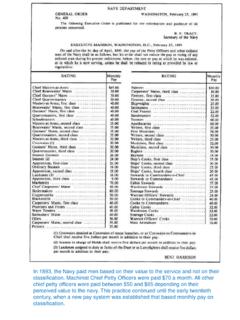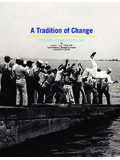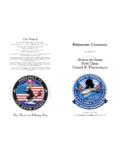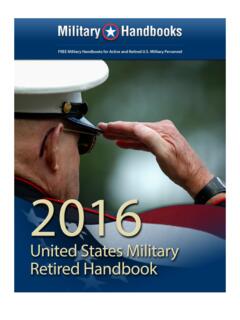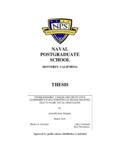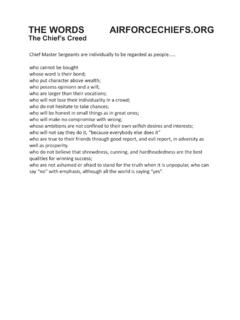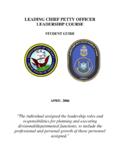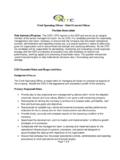Transcription of ENABLING OBJECTIVES DESCRIBE - Welcome to the …
1 TOPIC 1. HISTORY AND TRADITIONS OF THE chief PETTY OFFICER. ENABLING OBJECTIVES : These readings are suggested as additional sources of DESCRIBE the history of the chief Petty Officer information. Although not required, you are encouraged uniform and rate. to review these readings to broaden your perspective of the lesson. DESCRIBE the traditions of the chief Petty Officer. 1. Bearden, Bill. The Blue Jackets Manual, Twenty- ALLOTTED TEACHING TIME: first Edition. Naval Institute Press. Annapolis, Maryland. 1990. hours 2. Hagan, John. Core Values and Naval Heritage, STUDENT PREPARATION: Intertwined and Inseparable. Direct Line (Special Edition), Vol 16, May-June 1996. A. Student Support Materials: 1. Student Guide, NAVEDTRA 38202A, (1 per student). B. Reference Publications: None INSTRUCTOR PREPARATION: A.
2 Review related student material. B. Reference Publications: None C. Supplemental References: chief Petty Officer Indoctrination 1-1. TOPIC 1. HISTORY AND TRADITIONS OF THE chief PETTY OFFICER. D. Training Materials Required: c. TP 1-3 CPO History and Traditions 1. From Student Guide: d. TP 1-4 Why Study History? a. TS 1 History and Traditions of the chief Petty Officer e. TP 1-5 Pre-Revolutionary War to End of Civil War b. OS 1-1 History and Traditions of the chief Petty Officer f. TP 1-6 Civil War World War I. c. IS 1-2 History of the chief Petty Officer g. TP 1-7 End of World War I World War II. Grade h. TP 1-8 After World War II Present Day d. IS 1-3 The Fouled Anchor 3. Video Tapes: None e. IS 1-4 History of the CPO Charge Book f. IS 1-5 History of the Master chief Petty Officer of the Navy 2.
3 Transparencies: a. TP 1-1 History And Traditions of the chief Petty Officer b. TP 1-2 ENABLING OBJECTIVES chief Petty Officer Indoctrination 1-2. DISCUSSION POINT RELATED INSTRUCTOR ACTIVITY. 1. Introduction 1. Display TP-1, History and Traditions of the chief Petty Officer. In this lesson, we will discuss the history of the chief Petty Officer and the traditions that over the years have Display TP-2, ENABLING OBJECTIVES . set the rank of chief Petty Officer in the United States Navy apart from the pay grade of E-7 in other branches Refer to OS 1-1, History and Traditions of the chief of military service. Petty Officer. Display TP 1-3, CPO History and Traditions. 2. Why study history 2. Display TP 1-4, Why Study History? This topic is important to you as a new chief , because you now have the distinct responsibility of knowing and Question: Why are we discussing CPO history?
4 Passing along this significant information. CPOs are responsible for knowing and History and traditions exert a profound influence upon passing along this information human behavior. The effect is particularly marked in professional organizations such as the military which - History and traditions influence behavior because of imposed discipline - lends itself to passing on and perpetuating venerated customs, heroic traditions, and dignified ceremonies. Naval history is a continuum of success, and its customs, traditions, and memory of past heroes help today's Sailor identify with the Navy's Core Values. Traditions bind us to the past and, at the same time, lend an air of dignity and respect to the modern Navy. chief Petty Officer Indoctrination 1-3. DISCUSSION POINT RELATED INSTRUCTOR ACTIVITY.
5 3. Pre-revolutionary War to end of Civil War 3. Display TP 1-5, Pre-Revolutionary War to End of Civil War. Refer to IS 1-2, History of chief Petty Officer Grade Direct the students to IS 1-2 and tell them to read as homework. a. First use of the term chief a. Question: When was the term chief first used? The earliest example of the use of chief was on the In 1776, Jacob Wasbie, a Cook's Mate, was Continental Navy warship Alfred when Jacob promoted to chief Cook.. Wasbie, a Cook's Mate, was promoted to chief Cook on June 1, 1776. b. chief Petty Officer means Primary Petty Officer b. Question: Prior to 1865, was the title of chief Petty Officer one of function or of rank? Why? Before 1865, there were two classes of Petty Officers: Petty Officers of the Line, and Petty Function, because the Master at Arms was Officers of the Staff.
6 The Master at Arms title of considered the primary Petty Officer by virtue of chief Petty Officer was one of function not rank with job description emphasis of the word chief or primary. This is stated in the Navy Regulations from that time frame. chief Petty Officer Indoctrination 1-4. DISCUSSION POINT RELATED INSTRUCTOR ACTIVITY. The Master-at-Arms will be the chief Petty Officer of the ship in which he shall serve. All orders from him in regard to the police of the vessel, the preservation of order, and obedience to regulations must be obeyed by all Petty Officers and others of the crew. But he shall have no right to succession in command, and shall exercise no authority in matters not specified above. c. Special set of values c. Question: What distinction is made between the early use of the term chief Petty Officer and leadership It is evident that even in the earliest reference of the ability?
7 Use of the term chief Petty Officer that a heightened sense of responsibility and trust was Evidence of sound leadership and a sense of good expected of the individuals who held the title. So it is values based on the trust and responsibility of the easy to see that they had earned this trust by their position. sense of good values and demonstration of sound leadership. chief Petty Officer Indoctrination 1-5. DISCUSSION POINT RELATED INSTRUCTOR ACTIVITY. 4. Civil War through World War I 4. Display TP 1-6, Civil War World War I. Question: When did the Navy divide job descriptions into rates? 1885. a. Division into rates a. Question: Were the rates mentioned in the Navy Regulations of 1885 as Chiefs actually chief Petty In 1885 the dividing of enlisted men into rates from Officers?
8 Seaman to First Class Petty Officer occurred. When looking at Navy Regulations Circular No. 41 (Table No, they were first Class Petty Officers. Their 1-1), you will see that the Petty Officer First Class titles were associated with assignment of duties, category carried chief Boatswains Mates, chief not a separate pay grade. Gunners Mates, and chief Quartermasters. However, these were titles associated with assignment of duties not separate pay grades. chief Petty Officer Indoctrination 1-6. DISCUSSION POINT RELATED INSTRUCTOR ACTIVITY. b. Establishment of chief Petty Officer grade b. Question: When was the CPO grade established? It wasn't until 1893 that the Navy established the pay 1893. grade of chief Petty Officer. Refer to Navy Circular No. 1 (Table 1-2) and General Order No.
9 Question: Who was the first chief Petty Officer? 409 (Table 1-3). There was no one person who is known as the first chief Petty Officer. Nearly all Sailors carrying the rating of Petty Officer First Class in 1893 were automatically shifted to the CPO level. c. Development of rating badges and the Fouled Anchor c. Refer to IS 1-3, The Fouled Anchor Originally the Master-at-Arms rating badge had three Direct the students to read IS 1-3 (approximately 5. chevrons, an eagle and three arcs (rockers). It was minutes). the basis for today's CPO chevron which has a single rocker and became official in 1894. Question: How was the Fouled Anchor first used with the chief Petty Officer's uniform? The Fouled Anchor was first used as a cap device with the chief Petty Officer uniform in 1905.
10 In 1905 the Fouled Anchor was used as a CPO. cap device. chief Petty Officer Indoctrination 1-7. DISCUSSION POINT RELATED INSTRUCTOR ACTIVITY. d. The first women chief Petty Officers d. Question: Who may be considered the first female chief ? Later during World War I the Secretary of the Navy authorized the enlistment of women in the Navy. chief Yeoman Loretta P. Walsh They were given the designation, Yeoman (F) and came to be called, Yeomanettes. Loretta Perfectus Walsh may be the first Yeoman (F). She was sworn in on 21 March 1917 as a chief Yeoman. e. First woman's uniform The first enlisted woman's uniform was comprised of a single breasted coat, blue in winter and white in summer, long gull bottomed skirts and a straight- brimmed Sailor hat, blue felt in winter and white straw.
